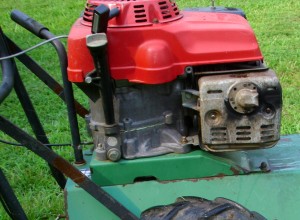 It’s one thing to have something break on your Billy Goat from wear and tear. It’s another to pull your machine out of storage and find you have frozen cables, sticky levers, and spark plugs that don’t want to leave their cylinders. How can you keep rust from damaging your equipment?
It’s one thing to have something break on your Billy Goat from wear and tear. It’s another to pull your machine out of storage and find you have frozen cables, sticky levers, and spark plugs that don’t want to leave their cylinders. How can you keep rust from damaging your equipment?
The Four Types of Rust and Their Causes
Not all rust is alike. Identifying the type of rust on your machine can tell you how it formed, and what you need to do to prevent it.
Red rust is a ferric oxide. It forms when iron is exposed to high levels of moisture and oxygen. Ferric oxide molecules are larger than iron, so it forms expanding layers on the surface of metal components. Eventually, these layers flake off, exposing more iron to oxygen. More rust is created, and more metal is lost. This makes it the most damaging type of rust.
Yellow rust is iron oxide-hydroxide. It forms when the iron is submerged, typically from water dripping into cracks and crevices on metal parts. This is common on poorly covered equipment and on cables surrounded by housings.
Brown rust is a type of iron oxide. This rust forms in spots on contaminated metal parts, usually in environments with high humidity. This type of rust is commonly found on unprotected bearings.
Black rust is another type of iron oxide. It forms on parts exposed to moisture, but not oxygen. This may show up beneath red rust, or on parts caked in dirt.
Manufacturing Strategies for Stopping Rust
The battle against rust starts at the factory.
If the oxygen can’t reach the metal, the metal can’t rust. Painting a metal part seals the surface. Chrome creates a hard layer on handles, but it’s expensive and doesn’t work well in all environments.
Stainless steel contains chromium, which bonds more readily with oxygen than iron does. The result is chromium oxide, which creates a protective layer. As long as there’s plenty of chromium left in the steel, the metal is rustproof. This makes it the best choice for control cables. However, stainless steel can’t handle high temperatures well, so it’s not used for engine components.
Lubricants don’t just reduce friction, they also block and absorb moisture. That’s why Billy Goat uses and recommends waterproof grease for their bearings and axles.
Preventing Rust on your Equipment
Stopping rust is easier than removing it. Here’s how you can keep your equipment rust-free during use and storage.
-Keep your equipment clean and dry
Lawn vacuums and debris loaders move dusty materials, so they need frequent cleaning. Never use a pressure washer on your equipment, and use only dry brushes and rags when cleaning the engine. Otherwise, you may contaminate grease and oil with water.
The core tines on your aerator should eject cores during use. If the tines are clogged with dirt after use, they may be worn out.
– Use touch-up paint
Briggs & Stratton and Honda Engines both offer small bottles of paint to cover up chips. If rust has already formed, remove it with a wire brush or apply a rust converting primer before applying the paint.
– Keep grease fresh
Dry grease shrinks and flakes away from bearings, exposing them to the elements. Contaminated grease can hold moisture against metal components. Adding new grease pushes out old grease and moisture.
– Apply oil to bare metal surfaces
Before you store your equipment, spray fogging oil over exposed metal. This oil leaves a protective film that blocks oxygen and moisture.
– Lubricate cables before storage
Water displacers like WD-40 do exactly that: they push water away from components. They don’t provide protection or lubrication. Instead, coat the cables in silicone lubricant or a non-detergent oil to create a protective barrier.
– Keep chains clean and oiled
Billy Goat walk-behind aerators use a partially exposed chain drive to the wheels. Use an aerosol chain cleaner and brush to remove oil and dirt, then apply a chain oil. Do not use chainsaw bar oil. This extra-tacky oil will make dirt cling to the chain, increasing wear.
– Seal the combustion chamber
When you’re ready to store your equipment, gently pull the starter handle until you feel resistance. This positions the valvetrain so that both the intake and exhaust valves are closed.
– Choose your storage location carefully
While storing equipment outdoors isn’t great, putting a tarp over it can be worse. This can trap moisture against metal components, promoting rust. If you can, keep your Billy Goat equipment in a shed or a carport.
Everything Thing You Need to Fix Your Billy Goat Straight from Your Browser
Billy Goat Parts is a certified dealer for Billy Goat and their partners including Briggs & Stratton, Subaru Power, and Honda Engines. That means you can get replacements for everything on your equipment from one place. Ordering is easy, too: just select your model and serial number, and our site will show you what will fit. There are even factory diagrams, so you can see exactly what you’re ordering. Visit us at www.billygoatparts.com. We ship across the United States and Canada.
